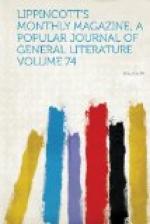Hurrying on, we skirt one of Pope’s outlying manors, in his time the seat of his friend Bathurst and the haunt of Addison, Prior, Congreve and Gay, and leave southward, toward the Thames, Horton, the cradle of Milton. A marble in its ivy-grown church is inscribed to the memory of his mother, ob. 1637. At Horton were composed, or inspired, Lycidas, L’Allegro, Il Penseroso, Comus and others of his nominally minor but really sweetest and most enjoyable poems. In this retirement the Muse paid him her earliest visits, before he had thrown himself away on politics or Canaanitish mythology. Peeping in upon his handsome young face in its golden setting of blonde curls,
Through the sweetbrier or the vine,
Or the twisted eglantine,
she wooed him to better work than reporting the debates of the archangels or calling the roll of Tophet. Had he confined himself to this tenderer field, the world would have been the gainer. He might not have “made the word Miltonic mean sublime,” but we can spare a little of the sublime to get some more of the beautiful.
To reach Milton, however, we have run off of the track badly. His Eden is no station on the Great Western. We shall balance this southward divergence with a corresponding one to the north from Slough, the last station ere reaching Windsor. We may give a go-by for the moment to the halls of kings, do homage to him who treated them similarly, and point, in preference, to where,
in
many a mouldering heap,
The rude forefathers of the hamlet sleep.
They show Gray’s tomb in Stoke Pogis church, and his house, West End Cottage, half a mile distant. The ingredients of his Elegy—actually the greatest, but in his judgment among the least, of his few works—exist all around. “The rugged elm,” “the ivy-mantled tower,” and “the yew tree’s shade,” the most specific among the simple “properties” of his little spectacle, are common to so many places that there are several competitors for the honor of having furnished them. The cocks, ploughmen, herds and owls cannot, of course, at this late day be identified. Gray could not have done it himself. He drew from general memory, in his closet, and not bit by bit on his thumb-nail from chance-met objects as he went along. Had his conception and rendering of the theme been due to the direct impression upon his mind of its several aspects and constituents, he would have more thoroughly appreciated his work. He could not understand its popularity, any more than Campbell could that of Ye Mariners of England, which he pronounced “d——d drum-and-trumpet verses.” Gray used to say, “with a good deal of acrimony,” that the Elegy “owed its popularity entirely to the subject, and the public would have received it as well had it been written entirely in prose.” Had it been written in prose or in the inventory style of poetry, it would have been forgotten long ago, like so much else of that kind.




